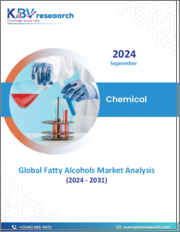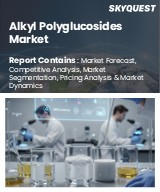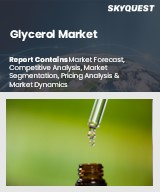
|
시장보고서
상품코드
1565198
세계의 지방족 알코올 시장 규모, 점유율, 동향 분석 리포트 : 유형별, 용도별, 지역별, 전망과 예측(2024-2031년)Global Fatty Alcohols Market Size, Share & Trends Analysis Report By Type (Long Chain, Pure & Mid Cut, Short Chain, and Higher Chain), By Application, By Regional Outlook and Forecast, 2024 - 2031 |
||||||
지방족 알코올 시장 규모는 예측 기간 중 5.5%의 CAGR로 시장이 성장하며, 2031년까지 75억 달러에 달할 것으로 예상되고 있습니다. 2023년에는 시장은 3,352.8 킬로톤에 달하며, 22.9%(2020-2023년)의 성장을 달성했습니다.
또한 글리세롤 모노스테아레이트(GMS) 및 소르비탄 에스테르와 같은 지방족 알코올은 식품 및 음료 배합에서 유화제 및 안정제 역할을 할 수 있습니다. 이들은 안정적인 에멀젼을 만들어 성분의 분리를 방지하고 유제품, 빵, 과자, 가공식품과 같은 제품의 질감과 입맛을 개선합니다. 지방족 알코올은 식품의 질감과 일관성, 특히 부드러움, 크리미함 또는 점성이 요구되는 용도에서 식품의 질감과 일관성에 기여합니다. 이들은 아이스크림, 마가린, 스프레드, 소스 등에 사용되어 감각적 특성과 소비자 선호도를 높입니다. 따라서 식품 및 음료 산업의 확장이 시장 성장을 주도하고 있습니다.
그러나 지방족 알코올은 주로 팜유, 코코넛 오일 및 기타 식물성 오일과 같은 천연 자원에서 추출됩니다. 이러한 자원은 기상 조건, 농업 생산량, 지정학적 안정성, 공급망 혼란 등 다양한 요인으로 인해 가격 변동에 영향을 받습니다. 악천후는 작물 수확량을 크게 감소시켜 공급 부족과 원자재 가격 상승으로 이어질 수 있습니다. 운송 네트워크의 혼란은 지연과 비용 증가로 이어져 가격 변동을 더욱 유발할 수 있습니다. 따라서 원자재 가격의 변동은 시장 성장을 방해하고 있습니다.
유형별 전망
유형에 따라 시장은 단쇄, 순수 및 중쇄, 장쇄, 고쇄로 나뉩니다. 2023년에는 장쇄 부문이 시장에서 51%의 매출 점유율을 차지했습니다. 양적으로 2031년까지 2,157.5 킬로톤의 장쇄 지방족 알코올이 사용될 것으로 예상됩니다. 장쇄 지방족 알코올, 일반적으로 탄소 사슬 길이가 C16 이상인 장쇄 지방족 알코올은 단쇄 알코올에 비해 성능이 향상되었습니다. 우수한 연화제, 보습 및 컨디셔닝 특성을 나타내며 크림, 로션, 헤어 케어 제제 등 퍼스널케어 제품에 가장 적합한 성분입니다.
용도 전망
용도에 따라 시장은 비누 및 세제, 퍼스널케어, 가소제, 윤활유, 제약 제제, 아민으로 분류됩니다. 2023년 윤활유 부문은 지방족 알코올 시장에서 11%의 매출 점유율을 차지할 것으로 예상됩니다. 양적으로 2031년까지 541.1kg의 지방족 알코올이 윤활유에 사용될 것으로 예상됩니다. 지방족 알코올은 윤활 특성을 가지고 있으므로 윤활유 배합에 적합한 첨가제입니다. 지방족 알코올은 움직이는 표면 사이의 마찰을 줄이고 마모를 방지하여 기계 및 장비의 수명을 연장합니다. 지방족 알코올은 오일과 그리스의 윤활성을 향상시켜 다양한 산업 용도에서 성능을 향상시킵니다.
지역 전망
지역별로 시장은 북미, 유럽, 아시아태평양, 라틴아메리카, 중동 및 아프리카로 분석되었습니다. 아시아태평양은 2023년 시장에서 40%의 매출 점유율을 차지할 것으로 예상됩니다. 양적으로는 2031년 이 지역에서 2,076.5 킬로톤의 지방족 알코올이 활용될 것으로 예상됩니다. 아시아태평양에는 중국, 일본, 한국, 인도 등 세계 최대 규모의 퍼스널케어 산업이 있습니다. 스킨케어, 헤어케어, 화장품에 대한 수요는 인구 증가, 도시화, 미용 동향 변화로 인해 증가하고 있습니다.
목차
제1장 시장 범위와 조사 방법
- 시장의 정의
- 목적
- 시장 범위
- 세분화
- 조사 방법
제2장 시장 개관
- 주요 하이라이트
제3장 시장 개요
- 서론
- 개요
- 시장 구성과 시나리오
- 개요
- 시장에 영향을 미치는 주요 요인
- 시장 성장 촉진요인
- 시장 성장 억제요인
- 시장 기회
- 시장이 해결해야 할 과제
- Porter's Five Forces 분석
제4장 세계 시장 : 유형별
- 세계의 롱 체인 시장 : 지역별
- 세계의 퓨어 & 미드 컷 시장 : 지역별
- 세계의 쇼트 체인 시장 : 지역별
- 세계의 하이 체인 시장 : 지역별
제5장 세계 시장 : 용도별
- 세계의 비누·세제 시장 : 지역별
- 세계의 퍼스널케어 시장 : 지역별
- 세계의 가소제 시장 : 지역별
- 세계의 윤활유 시장 : 지역별
- 세계의 의약품 제제 시장 : 지역별
- 세계의 아민 시장 : 지역별
- 세계의 기타 용도 시장 : 지역별
제6장 세계 시장 : 지역별
- 북미
- 북미의 시장 : 국가별
- 미국
- 캐나다
- 멕시코
- 기타 북미 지역
- 북미의 시장 : 국가별
- 유럽
- 유럽의 시장 : 국가별
- 독일
- 영국
- 프랑스
- 러시아
- 스페인
- 이탈리아
- 기타 유럽 지역
- 유럽의 시장 : 국가별
- 아시아태평양
- 아시아태평양의 시장 : 국가별
- 중국
- 일본
- 인도
- 한국
- 싱가포르
- 말레이시아
- 기타 아시아태평양
- 아시아태평양의 시장 : 국가별
- 라틴아메리카·중동 및 아프리카
- 라틴아메리카·중동 및 아프리카의 시장 : 국가별
- 브라질
- 아르헨티나
- 아랍에미리트
- 사우디아라비아
- 남아프리카공화국
- 나이지리아
- 기타 라틴아메리카·중동 및 아프리카 지역
- 라틴아메리카·중동 및 아프리카의 시장 : 국가별
제7장 기업 개요
- Wilmar International Limited
- Kao Corporation
- Kuala Lumpur Kepong Berhad(Davos Life Science)
- Arkema SA
- The Procter & Gamble Company
- Sasol Limited
- Emery Oleochemicals LLC
- BASF SE
- Univar Solutions, Inc
- SABIC(Saudi Arabian Oil Company)
제8장 지방족 알코올 시장의 성공 필수 조건
KSA 24.10.21The Global Fatty Alcohols Market size is expected to reach $7.5 billion by 2031, rising at a market growth of 5.5% CAGR during the forecast period. In the year 2023, the market attained a volume of 3,352.8 kilo tonnes, experiencing a growth of 22.9% (2020-2023).
Fatty alcohols such as cetyl alcohol, stearyl alcohol, and cetostearyl alcohol possess emollient properties that help moisturize, soften, and condition the skin. Therefore, the personal care segment procured 21% revenue share in the market in 2023. In terms of volume, 1,034.5 kilo tonnes of fatty alcohol is expected to be utilized in personal care by the year 2031. These fatty alcohols form a protective barrier on the skin's surface, preventing moisture loss and improving skin texture. Consumers increasingly prioritize hydration and skin health, so the demand for personal care products containing fatty alcohols has risen.
The pharmaceutical industry's adoption of fatty alcohols for various applications, such as excipients, emulsifiers, and penetration enhancers, leads to an increased demand for these compounds as pharmaceutical companies develop new drug formulations and delivery systems, the need for fatty alcohols as key ingredients grow, driving market demand. As the pharmaceutical sector expands globally and introduces novel therapies and treatments, the demand for fatty alcohols as essential ingredients in pharmaceutical formulations is expected to persist, contributing to the sustained growth of the fatty alcohols market. Thus, emerging applications in the pharmaceutical industry are propelling the market's growth.
Additionally, Fatty alcohols, such as glycerol monostearate (GMS) and sorbitan esters, act as emulsifiers and stabilizers in food and beverage formulations. They help to create stable emulsions, prevent separation of ingredients, and improve the texture and mouthfeel of products such as dairy, bakery, confectionery, and processed foods. Fatty alcohols contribute to the texture and consistency of food products, especially in applications where smoothness, creaminess, or viscosity are desired. They are used in ice creams, margarines, spreads, and sauces to enhance their sensory properties and consumer appeal. Therefore, expansion of the food and beverage industry is driving the growth of the market.
However, Fatty alcohols are primarily derived from natural sources such as palm, coconut, and other vegetable oils. These sources are subject to price fluctuations due to various factors, including weather conditions, agricultural yields, geopolitical stability, and supply chain disruptions. Adverse weather conditions can drastically reduce crop yields, leading to supply shortages and increased prices for these raw materials. Any disruptions in transportation networks can lead to delays and increased costs, further contributing to price volatility. Thus, raw material price volatility is hampering the growth of the market.
Type Outlook
Based on type, the market is divided into short chain, pure & mid cut, long chain, and higher chain. In 2023, the long chain segment held 51% revenue share in the market. In terms of volume, 2,157.5 kilo tonnes of Long-chain fatty alcohols is expected to be utilized by the year 2031. Long-chain fatty alcohols, typically those with carbon chain lengths of C16 and above, offer enhanced performance compared to their shorter-chain counterparts. They exhibit superior emollient, moisturizing, and conditioning properties, making them ideal ingredients for personal care products such as creams, lotions, and hair care formulations.
Application Outlook
On the basis of application, the market is segmented into soaps & detergents, personal care, plasticizers, lubricants, pharmaceutical formulation, and amines. In 2023, the lubricants segment acquired 11% revenue share in the fatty alcohols market. In terms of volume, 541.1 kilo tonnes of Fatty alcohols is expected to be utilized in lubricants by the year 2031. Fatty alcohols possess lubricating properties that make them suitable additives in lubricant formulations. They help reduce friction between moving surfaces, preventing wear and tear and extending the lifespan of machinery and equipment. Fatty alcohols improve the lubricity of oils and greases, enhancing their performance in various industrial applications.
Regional Outlook
Region-wise, the market is analyzed across North America, Europe, Asia-Pacific, and LAMEA. The Asia Pacific region attained 40% revenue share in the market in 2023. In terms of volume, 2,076.5 kilo tonnes of fatty alcohols is expected to be utilized by thi9s region in 2031. The Asia-Pacific region is home to some of the world's largest personal care industries, including China, Japan, South Korea, and India. The demand for skincare, haircare, and cosmetic products is fueled by a growing population, increasing urbanization, and changing beauty trends.
List of Key Companies Profiled
- Wilmar International Limited
- Kao Corporation
- Kuala Lumpur Kepong Berhad (Davos Life Science)
- Arkema S.A.
- The Procter & Gamble Company
- Sasol Limited
- Emery Oleochemicals LLC
- BASF SE
- Univar Solutions, Inc.
- Saudi Basic Industries Corporation (SABIC)
Global Fatty Alcohols Market Report Segmentation
By Type (Volume, Kilo Tonnes, USD Billion, 2020-2031)
- Long Chain
- Pure & Mid Cut
- Short Chain
- Higher Chain
By Application (Volume, Kilo Tonnes, USD Billion, 2020-2031
- Soaps & Detergents
- Personal Care
- Plasticizers
- Lubricants
- Pharmaceutical Formulation
- Amines
- Other Applications
By Geography (Volume, Kilo Tonnes, USD Billion, 2020-2031)
- North America
- US
- Canada
- Mexico
- Rest of North America
- Europe
- Germany
- UK
- France
- Russia
- Spain
- Italy
- Rest of Europe
- Asia Pacific
- China
- Japan
- India
- South Korea
- Singapore
- Malaysia
- Rest of Asia Pacific
- LAMEA
- Brazil
- Argentina
- UAE
- Saudi Arabia
- South Africa
- Nigeria
- Rest of LAMEA
Table of Contents
Chapter 1. Market Scope & Methodology
- 1.1 Market Definition
- 1.2 Objectives
- 1.3 Market Scope
- 1.4 Segmentation
- 1.4.1 Global Fatty Alcohols Market, by Type
- 1.4.2 Global Fatty Alcohols Market, by Application
- 1.4.3 Global Fatty Alcohols Market, by Geography
- 1.5 Methodology for the research
Chapter 2. Market at a Glance
- 2.1 Key Highlights
Chapter 3. Market Overview
- 3.1 Introduction
- 3.1.1 Overview
- 3.1.1.1 Market Composition and Scenario
- 3.1.1 Overview
- 3.2 Key Factors Impacting the Market
- 3.2.1 Market Drivers
- 3.2.2 Market Restraints
- 3.2.3 Market Opportunities
- 3.2.4 Market Challenges
- 3.3 Porter Five Forces Analysis
Chapter 4. Global Fatty Alcohols Market by Type
- 4.1 Global Long Chain Market by Region
- 4.2 Global Pure & Mid Cut Market by Region
- 4.3 Global Short Chain Market by Region
- 4.4 Global Higher Chain Market by Region
Chapter 5. Global Fatty Alcohols Market by Application
- 5.1 Global Soaps & Detergents Market by Region
- 5.2 Global Personal Care Market by Region
- 5.3 Global Plasticizers Market by Region
- 5.4 Global Lubricants Market by Region
- 5.5 Global Pharmaceutical Formulation Market by Region
- 5.6 Global Amines Market by Region
- 5.7 Global Other Applications Market by Region
Chapter 6. Global Fatty Alcohols Market by Region
- 6.1 North America Fatty Alcohols Market
- 6.1.1 North America Fatty Alcohols Market by Type
- 6.1.1.1 North America Long Chain Market by Country
- 6.1.1.2 North America Pure & Mid Cut Market by Country
- 6.1.1.3 North America Short Chain Market by Country
- 6.1.1.4 North America Higher Chain Market by Country
- 6.1.2 North America Fatty Alcohols Market by Application
- 6.1.2.1 North America Soaps & Detergents Market by Country
- 6.1.2.2 North America Personal Care Market by Country
- 6.1.2.3 North America Plasticizers Market by Country
- 6.1.2.4 North America Lubricants Market by Country
- 6.1.2.5 North America Pharmaceutical Formulation Market by Country
- 6.1.2.6 North America Amines Market by Country
- 6.1.2.7 North America Other Applications Market by Country
- 6.1.3 North America Fatty Alcohols Market by Country
- 6.1.3.1 US Fatty Alcohols Market
- 6.1.3.1.1 US Fatty Alcohols Market by Type
- 6.1.3.1.2 US Fatty Alcohols Market by Application
- 6.1.3.2 Canada Fatty Alcohols Market
- 6.1.3.2.1 Canada Fatty Alcohols Market by Type
- 6.1.3.2.2 Canada Fatty Alcohols Market by Application
- 6.1.3.3 Mexico Fatty Alcohols Market
- 6.1.3.3.1 Mexico Fatty Alcohols Market by Type
- 6.1.3.3.2 Mexico Fatty Alcohols Market by Application
- 6.1.3.4 Rest of North America Fatty Alcohols Market
- 6.1.3.4.1 Rest of North America Fatty Alcohols Market by Type
- 6.1.3.4.2 Rest of North America Fatty Alcohols Market by Application
- 6.1.3.1 US Fatty Alcohols Market
- 6.1.1 North America Fatty Alcohols Market by Type
- 6.2 Europe Fatty Alcohols Market
- 6.2.1 Europe Fatty Alcohols Market by Type
- 6.2.1.1 Europe Long Chain Market by Country
- 6.2.1.2 Europe Pure & Mid Cut Market by Country
- 6.2.1.3 Europe Short Chain Market by Country
- 6.2.1.4 Europe Higher Chain Market by Country
- 6.2.2 Europe Fatty Alcohols Market by Application
- 6.2.2.1 Europe Soaps & Detergents Market by Country
- 6.2.2.2 Europe Personal Care Market by Country
- 6.2.2.3 Europe Plasticizers Market by Country
- 6.2.2.4 Europe Lubricants Market by Country
- 6.2.2.5 Europe Pharmaceutical Formulation Market by Country
- 6.2.2.6 Europe Amines Market by Country
- 6.2.2.7 Europe Other Applications Market by Country
- 6.2.3 Europe Fatty Alcohols Market by Country
- 6.2.3.1 Germany Fatty Alcohols Market
- 6.2.3.1.1 Germany Fatty Alcohols Market by Type
- 6.2.3.1.2 Germany Fatty Alcohols Market by Application
- 6.2.3.2 UK Fatty Alcohols Market
- 6.2.3.2.1 UK Fatty Alcohols Market by Type
- 6.2.3.2.2 UK Fatty Alcohols Market by Application
- 6.2.3.3 France Fatty Alcohols Market
- 6.2.3.3.1 France Fatty Alcohols Market by Type
- 6.2.3.3.2 France Fatty Alcohols Market by Application
- 6.2.3.4 Russia Fatty Alcohols Market
- 6.2.3.4.1 Russia Fatty Alcohols Market by Type
- 6.2.3.4.2 Russia Fatty Alcohols Market by Application
- 6.2.3.5 Spain Fatty Alcohols Market
- 6.2.3.5.1 Spain Fatty Alcohols Market by Type
- 6.2.3.5.2 Spain Fatty Alcohols Market by Application
- 6.2.3.6 Italy Fatty Alcohols Market
- 6.2.3.6.1 Italy Fatty Alcohols Market by Type
- 6.2.3.6.2 Italy Fatty Alcohols Market by Application
- 6.2.3.7 Rest of Europe Fatty Alcohols Market
- 6.2.3.7.1 Rest of Europe Fatty Alcohols Market by Type
- 6.2.3.7.2 Rest of Europe Fatty Alcohols Market by Application
- 6.2.3.1 Germany Fatty Alcohols Market
- 6.2.1 Europe Fatty Alcohols Market by Type
- 6.3 Asia Pacific Fatty Alcohols Market
- 6.3.1 Asia Pacific Fatty Alcohols Market by Type
- 6.3.1.1 Asia Pacific Long Chain Market by Country
- 6.3.1.2 Asia Pacific Pure & Mid Cut Market by Country
- 6.3.1.3 Asia Pacific Short Chain Market by Country
- 6.3.1.4 Asia Pacific Higher Chain Market by Country
- 6.3.2 Asia Pacific Fatty Alcohols Market by Application
- 6.3.2.1 Asia Pacific Soaps & Detergents Market by Country
- 6.3.2.2 Asia Pacific Personal Care Market by Country
- 6.3.2.3 Asia Pacific Plasticizers Market by Country
- 6.3.2.4 Asia Pacific Lubricants Market by Country
- 6.3.2.5 Asia Pacific Pharmaceutical Formulation Market by Country
- 6.3.2.6 Asia Pacific Amines Market by Country
- 6.3.2.7 Asia Pacific Other Applications Market by Country
- 6.3.3 Asia Pacific Fatty Alcohols Market by Country
- 6.3.3.1 China Fatty Alcohols Market
- 6.3.3.1.1 China Fatty Alcohols Market by Type
- 6.3.3.1.2 China Fatty Alcohols Market by Application
- 6.3.3.2 Japan Fatty Alcohols Market
- 6.3.3.2.1 Japan Fatty Alcohols Market by Type
- 6.3.3.2.2 Japan Fatty Alcohols Market by Application
- 6.3.3.3 India Fatty Alcohols Market
- 6.3.3.3.1 India Fatty Alcohols Market by Type
- 6.3.3.3.2 India Fatty Alcohols Market by Application
- 6.3.3.4 South Korea Fatty Alcohols Market
- 6.3.3.4.1 South Korea Fatty Alcohols Market by Type
- 6.3.3.4.2 South Korea Fatty Alcohols Market by Application
- 6.3.3.5 Singapore Fatty Alcohols Market
- 6.3.3.5.1 Singapore Fatty Alcohols Market by Type
- 6.3.3.5.2 Singapore Fatty Alcohols Market by Application
- 6.3.3.6 Malaysia Fatty Alcohols Market
- 6.3.3.6.1 Malaysia Fatty Alcohols Market by Type
- 6.3.3.6.2 Malaysia Fatty Alcohols Market by Application
- 6.3.3.7 Rest of Asia Pacific Fatty Alcohols Market
- 6.3.3.7.1 Rest of Asia Pacific Fatty Alcohols Market by Type
- 6.3.3.7.2 Rest of Asia Pacific Fatty Alcohols Market by Application
- 6.3.3.1 China Fatty Alcohols Market
- 6.3.1 Asia Pacific Fatty Alcohols Market by Type
- 6.4 LAMEA Fatty Alcohols Market
- 6.4.1 LAMEA Fatty Alcohols Market by Type
- 6.4.1.1 LAMEA Long Chain Market by Country
- 6.4.1.2 LAMEA Pure & Mid Cut Market by Country
- 6.4.1.3 LAMEA Short Chain Market by Country
- 6.4.1.4 LAMEA Higher Chain Market by Country
- 6.4.2 LAMEA Fatty Alcohols Market by Application
- 6.4.2.1 LAMEA Soaps & Detergents Market by Country
- 6.4.2.2 LAMEA Personal Care Market by Country
- 6.4.2.3 LAMEA Plasticizers Market by Country
- 6.4.2.4 LAMEA Lubricants Market by Country
- 6.4.2.5 LAMEA Pharmaceutical Formulation Market by Country
- 6.4.2.6 LAMEA Amines Market by Country
- 6.4.2.7 LAMEA Other Applications Market by Country
- 6.4.3 LAMEA Fatty Alcohols Market by Country
- 6.4.3.1 Brazil Fatty Alcohols Market
- 6.4.3.1.1 Brazil Fatty Alcohols Market by Type
- 6.4.3.1.2 Brazil Fatty Alcohols Market by Application
- 6.4.3.2 Argentina Fatty Alcohols Market
- 6.4.3.2.1 Argentina Fatty Alcohols Market by Type
- 6.4.3.2.2 Argentina Fatty Alcohols Market by Application
- 6.4.3.3 UAE Fatty Alcohols Market
- 6.4.3.3.1 UAE Fatty Alcohols Market by Type
- 6.4.3.3.2 UAE Fatty Alcohols Market by Application
- 6.4.3.4 Saudi Arabia Fatty Alcohols Market
- 6.4.3.4.1 Saudi Arabia Fatty Alcohols Market by Type
- 6.4.3.4.2 Saudi Arabia Fatty Alcohols Market by Application
- 6.4.3.5 South Africa Fatty Alcohols Market
- 6.4.3.5.1 South Africa Fatty Alcohols Market by Type
- 6.4.3.5.2 South Africa Fatty Alcohols Market by Application
- 6.4.3.6 Nigeria Fatty Alcohols Market
- 6.4.3.6.1 Nigeria Fatty Alcohols Market by Type
- 6.4.3.6.2 Nigeria Fatty Alcohols Market by Application
- 6.4.3.7 Rest of LAMEA Fatty Alcohols Market
- 6.4.3.7.1 Rest of LAMEA Fatty Alcohols Market by Type
- 6.4.3.7.2 Rest of LAMEA Fatty Alcohols Market by Application
- 6.4.3.1 Brazil Fatty Alcohols Market
- 6.4.1 LAMEA Fatty Alcohols Market by Type
Chapter 7. Company Profiles
- 7.1 Wilmar International Limited
- 7.1.1 Company Overview
- 7.1.2 Financial Analysis
- 7.1.3 Segmental and Regional Analysis
- 7.2 Kao Corporation
- 7.2.1 Company Overview
- 7.2.2 Financial Analysis
- 7.2.3 Segmental and Regional Analysis
- 7.2.4 Research & Development Expenses
- 7.2.5 Recent strategies and developments:
- 7.2.5.1 Product Launches and Product Expansions:
- 7.2.6 SWOT Analysis
- 7.3 Kuala Lumpur Kepong Berhad (Davos Life Science)
- 7.3.1 Company Overview
- 7.3.2 Financial Analysis
- 7.3.3 Segmental and Regional Analysis
- 7.3.4 Research & Development Expenses
- 7.3.5 Recent strategies and developments:
- 7.3.5.1 Acquisition and Mergers:
- 7.3.6 SWOT Analysis
- 7.4 Arkema S.A.
- 7.4.1 Company Overview
- 7.4.2 Financial Analysis
- 7.4.3 Segmental and Regional Analysis
- 7.4.4 Research & Development Expenses
- 7.4.5 SWOT Analysis
- 7.5 The Procter & Gamble Company
- 7.5.1 Company Overview
- 7.5.2 Financial Analysis
- 7.5.3 Segmental and Regional Analysis
- 7.5.4 SWOT Analysis
- 7.6 Sasol Limited
- 7.6.1 Company Overview
- 7.6.2 Financial Analysis
- 7.6.3 Segmental and Regional Analysis
- 7.6.4 Research & Development Expenses
- 7.6.5 SWOT Analysis
- 7.7 Emery Oleochemicals LLC
- 7.7.1 Company Overview
- 7.7.2 SWOT Analysis
- 7.8 BASF SE
- 7.8.1 Company Overview
- 7.8.2 Financial Analysis
- 7.8.3 Segmental and Regional Analysis
- 7.8.4 Research & Development Expense
- 7.8.5 SWOT Analysis
- 7.9 Univar Solutions, Inc.
- 7.9.1 Company Overview
- 7.9.2 Financial Analysis
- 7.9.3 Segmental Analysis
- 7.9.4 SWOT Analysis
- 7.10. SABIC (Saudi Arabian Oil Company)
- 7.10.1 Company Overview
- 7.10.2 Financial Analysis
- 7.10.3 Segmental and Regional Analysis
- 7.10.4 SWOT Analysis



















